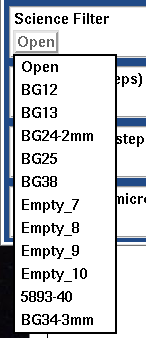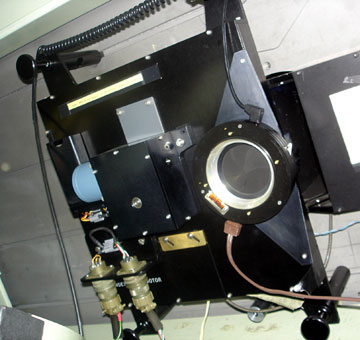Filter Wheel and Shutter
The filter wheel and shutter are mounted inside the camera room, just
downstream from the entrance slit, on camera-room side of the slit
bulkhead. They are reached from a wooden platform, a few feet
in front of the camera-room door.
Access to the assembly is usually only needed for changing filters or
performing tests that require the shutter to be manually opened. The
few filters routinely used for Hamilton work are permanently
mounted in the wheel, so observers rarely change filters.
However, in some cases, especially when making
longslit observations, observers may need to do so (see
changing filters).
Filter Wheel
Hamilton observations are generally done without a filter, as order
separation is accomplished with cross-dispersion. Filters are,
however, often needed for calibration exposures, especially flat
fields (see
calibrations).
The filter wheel is controlled from the spectrogrpah motor control
interface,
hammotor_gui, via the filter
menu shown below.
N.B.: Do not change filters if you have not
been trained in the procedure. If you do change filters, you
must remember to update the filter names in
hammotor_config_gui to reflect changes in the filterwheel's
contents! See
changing filters.

Science Filter Selection Menu
Shutter
A circular, diaphragm shutter is attached to the filter wheel. This
shutter controls the length of Hamilton exposures. Hamilton observers
need not be concerned with small errors introduced by shutter motion
or timing (which, in any case, are reasonably fast and accurate) as
the spectrograph is rarely, if ever, used for flux measurements.
The shutter receives its signals to open and close from the CCD
controller, after the observer has initiated an exposure. If the
shutter has been opened manually (there is a lever for doing so on its
outer rim), as is sometimes necessary when troubleshooting or
adjusting the alignment of a calibration source, be sure to shut it
manually when finished, as the CCD controller will not do so before
the end of the next exposure.
Diaphragm shutters do occasionally fail, either by not opening at all
or by opening very briefly and then partially or completely closing.
Such failures are not common, but should be considered when trouble
shooting low or absent flux, espcecially in cold weather.
Support Astronomers
(sa@ucolick.org)
Last modified: Sun Feb 13 17:22:49 PST 2011


